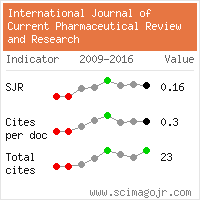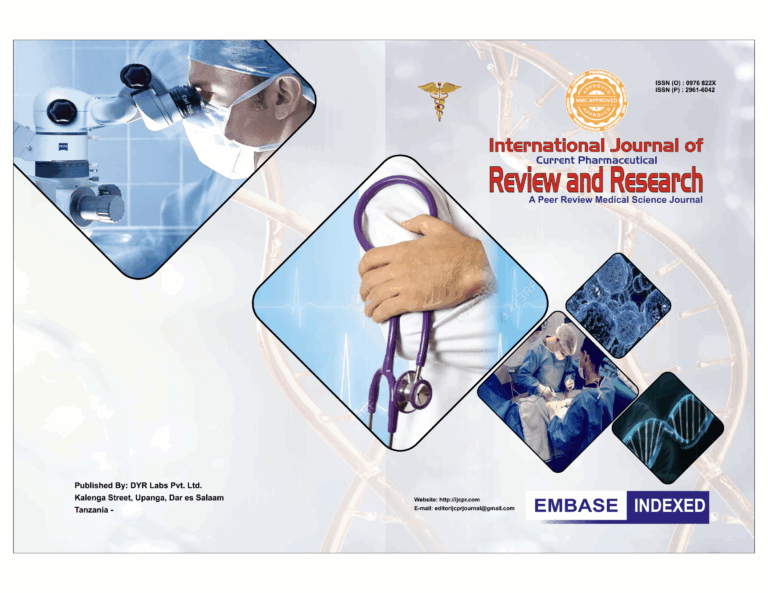1. NANOCRYSTALS: A NOVEL APPROACH IN THE DELIVERY OF HYDROPHOBIC DRUGS
Sharath Kumar, Krishnananda Kamath K, A R Shabaraya
Abstract
The distribution of medications into the relevant layers of the skin is referred to as dermal delivery. The delivery pathway has the potential to improve the active ingredients’ local bioavailability at their drug target. Nanocrystal-based formulations for dermal distribution have recently received a lot of attention due to their increased skin penetration. According to current research on nanocrystal for topical delivery, it could be a novel approach for all formulators struggling with poorly soluble drugs. Nanocrystals are a step forward from typical nanocarriers, offering 100 percent drug loading, a huge surface area, and the potential for follicular targeting. The skin structure and physiology, nanocrystal fabrication methods, and applications are discussed in this review.
2.
PARKINSON′S DETECTOR APPLICATION
Zvezdan Stojanović, Elvir Čajić, Eldin Turkić,Irma Ibrišimović
Abstract
This paper presents the Parkinson “Parkinson detector” application, which was developed in the Android environment and which should provide a modest contribution to the timely detection of the initial symptoms of Parkinson’s disease. The application was developed for a smartphone, commercially available to everyone and using existing, already built-in sensors, gyroscopes, and accelerometers. The development of the application „Parkinson Detector“ is intended for use on smartphones to control the condition of the human body, as well as prevention and signaling in case of detection of the initial state of the disease. In time detection of such severe degenerative diseases as Parkinson’s disease (PD) would enable the timely application of therapy and improve the chances of care and control of the disease, because currently, PD is diagnosed when wide areas of the brain are already damaged, motor symptoms of patients are evident and begin to influence their common activities. We believe that the use of the application „Parkinson Detector“ can help improve the quality of life, especially in the elderly.
3.
AVIER LEADLESS PACEMAKER (IMPLANTABLE PACEMAKER PULSE GENERATOR): A REVIEW
Ashok Kumar Sharma, Harshita Badoliya, Janvi Jain, Rohit Sharma, Vandana Sharma, Mukesh Sharma, Shankar Lal Soni, Vani Madaan
Abstract
Patients suffering from arrhythmias, bradycardia or chronic atrial arrhythmia with high degree blocks faced complications associated with transvenous pacemaker specially with old techniques which involved subcutaneous pocket, bleeding, infection and even a pneumothorax during surgical placement of pacemaker can be overcome by using leadless pacemaker. In 2013, the first leadless pacemaker was introduced in international clinical trials but removed from market due to its premature battery exhaustion. Then it redesigned with key design improvements. The leadless ll phase 2 trial then approved by FDA (Food and Drug Administration) on March 31
st, 2022. In trials study included 200 subjects across 43 sites in different countries. Procedures were performed without endotracheal intubation. The objective of this study was to evaluate the success of implantation, its performance and preclinical studies. In phase ll implantation success was 98%. Unique aspects of this device were improved implant success rate and low repositioning rates. The new design of leadless pacemaker is with dual – helix fixation mechanism which is specific to right atrium anatomy. The avier leadless pacemaker contains following components:
- The avier leadless pacemaker [LSP112V]
- Avier delivery system catheter [LSCD111]
- Avier link module [Model LSL02]
It is conditionally safe for use in MRI environment by following up proper instructions. The avier leadless pacemaker met its all safety and efficacy end points. Patients who have poorly integrated hardware such as drivelines, comorbidities associated with discomfort and infection. Experts predicted that advancement in transcutaneous charging capabilities will soon render large devices which may be completely implantable.
4.
APPROVECAMYZYOS (MAVACAMTEN) NEW APPROACH IN CONGESTIVE HEART FAILURE: A REVIEW
Mukesh Sharma, Rohit Sharma, Janvi Jain, Harshita Badoliya, Vandana Sharma, Ashok Kumar Sharma, Shankar Lal Soni, Vani Madaan
Abstract
FDA has approvecamyzyos (mavacamten) capsule. The main aim of camyzyos drug to treat obstructive hypertrophic cardiomyopathy (oHCM). Camyzyos, first and only FDA approved drug that inhibit the myosin inhibitor. camyzyos available in various range like, 2.5mg, 5mg, 10mg, 15mg, capsules for the treatment of adults with symptomatic obstructive hypertrophic cardiomyopathy. Mavacamten is a targeted inhibitor of cardiac myosin that reduces the number of myosin actin cross bridge and decreases contractility. Mavacamten is selective allosteric modulator of cardiac myosin ATPase. Currently available pharmacological symptoms of oHCM are not disease specific. oHCM is a monogenic C.V disorder that often goes undiagnosed and can provide a variety of symptoms like, shortness of birth, it causes sudden cardiac death. oHCM mainly causes due to excessive contraction of the left ventricle. In patients, camyzyos decrease the pressure gradient contributing to obstruction of VLOT.
Mavacamten trail show that mavacamten was superior to placebo at improving exercise capacity of health status. Some patients who take placebo HCM feel better, and some other patients develop side effects, but in the case of mavacamten try to give best pharmacological action, rarely produce side effect.
5.
STUDY TO EVALUATE THE SOCIODEMOGRAPHIC AND CLINICAL CHARACTERISTICS OF ORAL CANCER PATIENTS
Rohit Kumar Jha, Ritesh Kumar Sinha, Sumedha Gargy, Shalini Jha
Abstract
Objective: In the world, India is the nation with the fastest-growing trends in oral cancer incidences. It is a well-known truth that a person’s chance of survival is quite low if oral cancer has spread to an advanced stage. Examining the clinical profile of instances of oral cancer and its associated epidemiological characteristics was the research’s goal.
Method: This cross-sectional study was carried out at Rajendra Institute of Medical Sciences, Ranchi within 2 years. A pre-designed structured questionnaire was used to interview a total of 200 individuals. A 5% level of significance was assigned to the outcome after suitable statistical analyses were run.
Results: The patients were male (91.46%) and female (8.52) in gender, with a mean age of 47.67 (±11.557) years. Patients most frequently had mouth ulcers (82.3%) and trouble swallowing (5.2%) as their initial symptoms. The most afflicted areas were the tongue (41.1%) and buccal mucosa (46.4%). Most of the patients were from lower socioeconomic strata and were in advanced stages (Stage III and IV), with Stage III being the stage that was most common at presentation and Stage IV coming in second.
Conclusion: Males over the age of 41 and rural patients from lower socioeconomic classes had a higher incidence of oral cancer. The patients most often reported the first symptom was ulcers in the mouth. The most frequent location was the buccal mucosa, and the majority of the patients fell into the Stage III and Stage IV categories.
6.
DISC DRAG FOLLOWING SPONTANEOUSLY REGRESSED RETINOPATHY OF PREMATURITY: CLINICAL FEATURES AND VISUAL OUTCOMES
Anoop Mishra
Abstract
Purpose: To present the clinical spectrum, severity, visual acuity (VA) outcome, and associated ocular anomalies of disc drag in children with spontaneously regressed Retinopathy of Prematurity (ROP), an often ignored sequale of significance to long term vision.
Methods: The study was conducted at Department of Ophthalmology of Era’s Lucknow Medical College and Hospitals. The study is a Retrospectiveanalysis of 48 pediatric patients with spontaneously regressed ROP complicated with disc drag. Patient characteristics with demographic data and information on perinatal factors, such as gestational age, birth weight, and history of neonatal oxygen therapy, were obtained. Ophthalmic examinations consisted of best-corrected visual acuity (BCVA), slit-lamp anterior segment examination, indirect ophthalmoscopy and fundus photography to evaluate optic disc displacement, retinal folds and macula distortion. The severity of disc drag was graded as mild, moderate, and severe using clinical information and imaging. A descriptive analysis for associated ophthalmic findings including refractive errors, strabismus, nystagmus and retinal detachment was recorded. Statistical summaries were expressed in terms of descriptive statistics.
Results: The cohort’s mean gestational age was 30.5 ± 1.8 weeks and mean birth weight was 1250 ± 210 grams, and 60.4% of these infants were male. The majority of patients (64.6%) had unilateral disc drag, moderate in severity (43.7%). Retinal folds were found in 54.2% and macular distortion in 31.3%. The range of visual acuity was wide: 25% had visual acuity near normal (6/6 to 6/12), 45.8% had moderate visual impairment (6/18 to 6/36), and 29.2% were severely visually impaired (>6/36). The prevalence of those disorders was myopia (58.3%), strabismus (18.7%), and nystagmus (10.4%). Partial retinal detachment was an infrequent but observed in 6.3% of eyes. These results emphasize the diverse clinical significance of a disc drag on the visual function despite resolution of the primary disease process.
Conclusions: Disc drag is a clinically significant and potentially vision-threatening complication in children with spontaneously regressed ROP. The associated tractions that lead to ONH distortion and retinal folds result in dissimilar visual loss and associated ophthalmic comorbidities. Close ophthalmic monitoring including serial structural imaging and refractive assessment is crucial to identify progressive changes that may necessitate timely intervention with the goal of optimizing visual outcomes in this at-risk patient population.
6.
DISC DRAG FOLLOWING SPONTANEOUSLY REGRESSED RETINOPATHY OF PREMATURITY: CLINICAL FEATURES AND VISUAL OUTCOMES
Anoop Mishra
Abstract
Purpose: To present the clinical spectrum, severity, visual acuity (VA) outcome, and associated ocular anomalies of disc drag in children with spontaneously regressed Retinopathy of Prematurity (ROP), an often ignored sequale of significance to long term vision.
Methods: The study was conducted at Department of Ophthalmology of Era’s Lucknow Medical College and Hospitals. The study is a Retrospectiveanalysis of 48 pediatric patients with spontaneously regressed ROP complicated with disc drag. Patient characteristics with demographic data and information on perinatal factors, such as gestational age, birth weight, and history of neonatal oxygen therapy, were obtained. Ophthalmic examinations consisted of best-corrected visual acuity (BCVA), slit-lamp anterior segment examination, indirect ophthalmoscopy and fundus photography to evaluate optic disc displacement, retinal folds and macula distortion. The severity of disc drag was graded as mild, moderate, and severe using clinical information and imaging. A descriptive analysis for associated ophthalmic findings including refractive errors, strabismus, nystagmus and retinal detachment was recorded. Statistical summaries were expressed in terms of descriptive statistics.
Results: The cohort’s mean gestational age was 30.5 ± 1.8 weeks and mean birth weight was 1250 ± 210 grams, and 60.4% of these infants were male. The majority of patients (64.6%) had unilateral disc drag, moderate in severity (43.7%). Retinal folds were found in 54.2% and macular distortion in 31.3%. The range of visual acuity was wide: 25% had visual acuity near normal (6/6 to 6/12), 45.8% had moderate visual impairment (6/18 to 6/36), and 29.2% were severely visually impaired (>6/36). The prevalence of those disorders was myopia (58.3%), strabismus (18.7%), and nystagmus (10.4%). Partial retinal detachment was an infrequent but observed in 6.3% of eyes. These results emphasize the diverse clinical significance of a disc drag on the visual function despite resolution of the primary disease process.
Conclusions: Disc drag is a clinically significant and potentially vision-threatening complication in children with spontaneously regressed ROP. The associated tractions that lead to ONH distortion and retinal folds result in dissimilar visual loss and associated ophthalmic comorbidities. Close ophthalmic monitoring including serial structural imaging and refractive assessment is crucial to identify progressive changes that may necessitate timely intervention with the goal of optimizing visual outcomes in this at-risk patient population.


